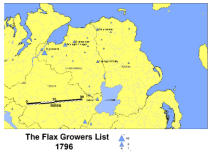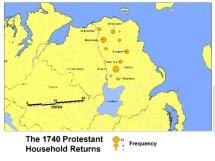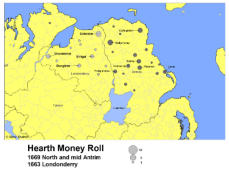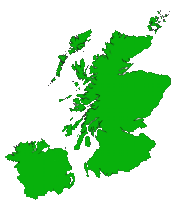The Griffith Valuation
The Griffiths Valuation was carried out between 1848 and 1864 provides detailed information on population distribution in mid-nineteenth century Ireland and the on property they possessed. The area units are based on the Parish and townland boundaries. The parish boundaries are on average larger than the District Electoral Division and therefore the “granulation” of the map is not as detailed as the 1901 Census map. Despite the passage of approximately 50 years, and the impact of the Great Famine, the patterns of distribution are remarkably similar.The Flax Growers List
Growing flax and spinning linen in Ireland can be dated to Medieval times. The late 17th century would see the industry begin the process of commercialization. Emigration of Huguenot weavers from France would stimulate the Irish industry. They brought with them spinning wheels and linen looms. By the 18th century the spinning wheel was a common household “appliance” with an active cottage industry augmenting family income. As the 18th century came to a close and industrialization became a force, the export of Irish linen sky-rocketed. Unable to keep up with demand, the Irish linen board provided incentives for rural farmers to grow flax. Those who had planted one acre of flax were awarded four spinning wheels, and those planting five acres were awarded a loom. The invention of the wet spinning wheel, suitable for spinning linen in the 1820s, and the adoption of steam power by factories would transform the industry. The 1870s would see 78 large flax spinning mills with a workforce of 43,000 with Belfast as the epicentre.The Hearth Money Roll
The Hearth Tax was introduced as a revenue measure in 1662. The Roll list the names of householders who were liable to pay tax on fireplaces in their home. The rate was at the rate of two shillings per hearth and as such was a “progressive” tax which fell more heavily on the wealthy. The list is not complete as many individuals found ways of avoiding the tax.The 1740 Protestant Household Returns
“In 1740, the Irish House of Commons required the compilation of returns of Protestant householders in the North of Ireland. The work was undertaken by the Hearth Money collectors in their various 'walks'. The original records of this survey were destroyed in Public Record Office of Ireland in 1922, but copies survive in the Tenison Grove transcripts and are entitled the 'Londonderry Survey'. In spite of the title the collection includes counties outside Londonderry, covering parts of Co. Antrim, Armagh, Down, Donegal and Tyrone. Information is provided for 37 parishes in Co. Londonderry, 21 in Co. Antrim, 4 in Co. Armagh, 2 in Co. Down and 3 in Co. Tyrone” - Lurgan Ancestry. Back to the Top



Census Substitutes

The Miller Surname Study

GeoGenealogy













